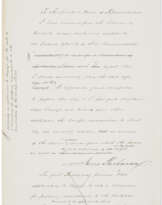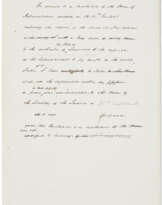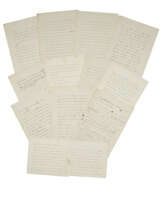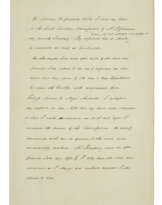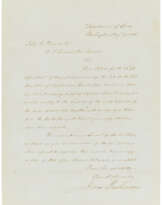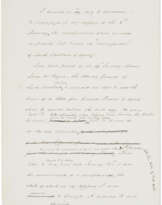ID 1119129
Lot 141 | Refusing to surrender Fort Sumter
Valeur estimée
$ 80 000 – 120 000
James Buchanan, 31 December 1860
BUCHANAN, James. (1791-1868); GLOSSBRENNER, Adam John (1810-1889). Autograph manuscript draft, Washignton, 31 December 1860.
19 pages, most 345 x 212mm. Seven pages in Buchanan's hand, the balance in the hand of his private secretary, Adam John Glossbrenner.
"In the harbor of Charleston, confronting each other are three forts belonging to the United States, over two of them the Palmetto flag waves & the stars and stripes of our Country wave over but one … To ask me to remove the American flag altogether from the port & harbor of Charleston this I cannot do."
James Buchanan's draft of his response to the South Carolina Commissioners refusing to surrender Fort Sumter. A revealing look at the beleaguered President's careful construction of his response to the demands of the South Carolina Commissioners for the surrender of Fort Sumter, a crisis exacerbated by Major John Anderson's decision to evacuate the indefensible Fort Moultrie for the more secure Fort Sumter, located a mile from the Charleston Harbor shoreline. While denying South Carolina's right to take the federal installation, he was adamant that the decision to evacuate Moultrie was Anderson's alone: "I never did send any reinforcements to the harbor of Charleston nor did I ever authorize the officer in command to change the relative military status of the Forts. On the 11th December 1860 the Secretary of War addressed an order to Major Anderson which was never brought to my knowledge until the 21st instant ...The last letter from Major Anderson before his removal to Fort Sumpter (sic) dated on the 22nd inst. & received on the 26th proves conclusively that he was not mistaken as to the character of his instructions; but that he acted upon his own responsibility. But he is a gallant & brave officer & ought not to be condemned without a hearing. I most deeply regret his action. The true remedy of it would have been an order to him to return to Fort Moultrie with his command & restored all things in status quo." Interestingly, Buchanan deleted the next passage, likely not wanting to offer any additional legitimacy to actions taken by the State of South Carolina: "Had you asked me for such an order it would have been instantly granted without wanting or asking for any explanation. But the Convention acting in their own discretion have taken the law into their own hands. They neither asked nor waited for any explanation." Following this deleted passage, the President continues: "The removal took place on Wednesday night & on Thursday afternoon we are informed by the Telegraph that the Palmetto flag was raised yesterday afternoon over the Custom House & Post Office at 5 PM. About the same hour the Palmetto flag floated out to the breeze at Castle Pinckney & a large military force went over last night to Fort Moultrie. Both the Custom House & Post Office were the property of the United States. Now it is I presume impossible to restore the status quo. In the harbor of Charleston, confronting each other are three forts belonging to the United States, over two of them the Palmetto flag waves & the stars and stripes of our Country wave over but one. Under these circumstances you urge upon me 'the immediate withdrawal of the troops from the harbor of Charleston.' This would be voluntarily to surrender the third fort after the other two have been taken possession of by South Carolina: To ask me to remove the American flag altogether from the port & harbor of Charleston this I cannot do." Published in John Basset More, ed., The Works of James Buchanan. Philadelphia & London: J. B. Lippincott Company, 1910. Vol. 11, pp. 79-84.
[With:] [BUCHANAN, James. (1791-1868), GLOSSBRENNER, Adam John (1810-1889)]. Partial draft autograph letter [in Glossbrenner's hand] to the Senate and House of Representatives [Washington, ca. 2 January 1861]. 1 page, 345 x 211mm. A partial transmittal leaf, noting the transmittal of letters from the South Carolina "'Commissioners'" as well as "what is denominated the Ordinance of Secession of South Carolina from the Union … . It is well known that I do not recognize the constitutional or reserved right of any state to withdraw from the Union without the consent of her sister states. On this question I have nothing to add…." Not published in Works.
| Artiste: | Adam John Glossbrenner (1810 - 1889) James Buchanan (1791 - 1868) |
|---|---|
| Catégorie maison de vente aux enchères: | Lettres, documents et manuscrits |
| Artiste: | Adam John Glossbrenner (1810 - 1889) James Buchanan (1791 - 1868) |
|---|---|
| Catégorie maison de vente aux enchères: | Lettres, documents et manuscrits |
| Adresse de l'enchère |
CHRISTIE'S 20 Rockefeller Plaza 10020 New York Etats-Unis | ||||||||||||||
|---|---|---|---|---|---|---|---|---|---|---|---|---|---|---|---|
| Aperçu |
| ||||||||||||||
| Téléphone | +1 212 636 2000 | ||||||||||||||
| Fax | +1 212 636 4930 | ||||||||||||||
| Conditions d'utilisation | Conditions d'utilisation | ||||||||||||||
| transport |
Service postal Service de messagerie ramassage par vous-même | ||||||||||||||
| Modes de paiement |
Virement bancaire | ||||||||||||||
| Heures d'ouverture | Heures d'ouverture
|






